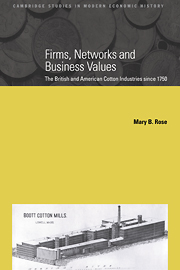Book contents
- Frontmatter
- Contents
- List of figures
- List of tables
- Acknowledgements
- 1 Introduction: the evolution of two industries
- Part I The culture of business networks 1750–1860
- Part II Continuity and change
- 6 Consolidation and change, 1860–1914
- 7 Prosperity and decay in war and peace, 1914–39
- 8 The turbulent years, 1939–80: the politics of decline
- 9 Conclusion
- References
- Index
- Cambridge Studies in Modern Economic History
6 - Consolidation and change, 1860–1914
Published online by Cambridge University Press: 12 September 2009
- Frontmatter
- Contents
- List of figures
- List of tables
- Acknowledgements
- 1 Introduction: the evolution of two industries
- Part I The culture of business networks 1750–1860
- Part II Continuity and change
- 6 Consolidation and change, 1860–1914
- 7 Prosperity and decay in war and peace, 1914–39
- 8 The turbulent years, 1939–80: the politics of decline
- 9 Conclusion
- References
- Index
- Cambridge Studies in Modern Economic History
Summary
The preceding four chapters have explored the forces which shaped the evolution of business attitudes and the emergence of networks in the British and American cotton industries before 1860. Their findings are summarised in Table 6.1 which demonstrates that, whilst sharing the common concerns of production, profitability and market penetration, businessmen on either side of the Atlantic often displayed differences in priorities, perceptions and behaviour. These were born of the varying social, political and economic forces to which they were subject, and in turn were translated into the culture of business. For example, the production-driven strategies, detected in much of the United States cotton industry, clearly only partly resulted from resource allocation. Rather they derived from a combination of collective approaches to community development traceable even to the colonial period, from a faith in the power of technology which was rarely contradicted by the workforce and the habitual transience of the workforce plus a confidence in a protected domestic market. Yet in Britain eighteenth- and early nineteenth-century infant industry protection against cheap colonial imports allowed the successful development of cotton manufacturing. However, the constraints of a small, but strongly differentiated domestic market, combined with overseas opportunities, brought with it greater market complexity than was then the case in America and significantly enhanced the relative power of mercantile groups, as opposed to manufacturers. This factor, combined with a need for cheap imported raw materials, a reliance on overseas markets for business expansion and the social and political forces which brought free trade, led to a shift in government policy in favour of liberalism.
- Type
- Chapter
- Information
- Firms, Networks and Business ValuesThe British and American Cotton Industries since 1750, pp. 159 - 197Publisher: Cambridge University PressPrint publication year: 2000

